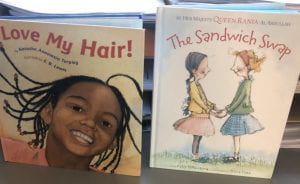Essential Questions:
- Who am I at this particular time?
- Can my identity change?
- Who is in this community?
- What does this mean for me being in this space with my identities?
- How do I belong?
Reflective Practice:
I didn’t know that this journey would lead me to think more about myself and my own personal experiences as an Afro-Latina. Growing up with my brown skin and thick hair (which I would later learn was naturally curly after I stopped perming it), I rarely talked about my racial or ethnic identity because it was emotional and…complicated.
During our study, I often shared my personal experiences with the children in regards to being labeled based on the texture of my hair, the color of my skin, or my facial features. In my own life, out in the world, when I share “what I am” the response is usually…”but you look…” People often assume that I am keeping a secret from them or that I can speak Spanish fluently.
As we began to explore our identities in Second Grade, many topics of our discussions focused on making assumptions about people based on how they look, as well as thinking of various ways to learn about, appreciate, and respect people’s identities. In the beginning of the year, we started to build our classroom community by learning  more about each other through our baby pictures, oral, and written stories. We often referred to our class chart, which listed various identifiers and stressed the importance of being respectful of them throughout the year. Literature was also used to reinforce the idea that people identify in different ways and that our identities can change over time.
more about each other through our baby pictures, oral, and written stories. We often referred to our class chart, which listed various identifiers and stressed the importance of being respectful of them throughout the year. Literature was also used to reinforce the idea that people identify in different ways and that our identities can change over time.
In addition to the essential questions, other questions and topics of discussion came up:
- Can you tell if someone is kind just by looking at them?
- Why would someone talk to a homeless person?
- Can you tell someone’s gender, race or ethnicity just by looking at them?
- Can you celebrate and appreciate a culture or religion that is not your own?
- If you move, or relocate somewhere else, does that mean you have to let go of parts of your identity (for example, your name, family traditions, language, etc..)?
I did not anticipate certain scenarios or conversations that would eventually arise during this study, for example, When we shared our baby photos with each other, one child said to another, “but you look ______.” The child who shared the photo soon began to cry and expressed her frustration. She later explained (with teacher support) that she just wanted her partner to listen to her story without judgement. I could definitely connect with this child’s frustration on a personal level.
As the year progresses, I look forward to continuing this important work both personally and professionally this year.


Tasha, thanks for sharing. These conversations seem so important as crucial first steps in developing listening skills in our learners. And here I mean something more than listening in order to respond, but listening that aims towards understanding through empathy. For our white students, these are valuable beginning moments to learn to hear the story of another as a truth and not simply as statements to be parsed or questioned in terms of the listener’s own (limited) world view.